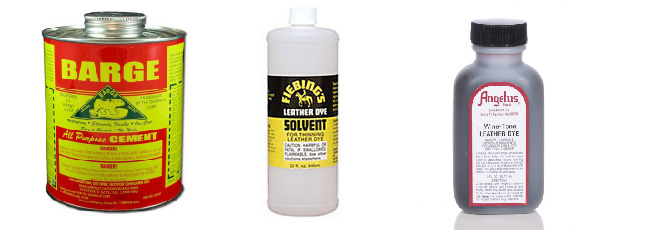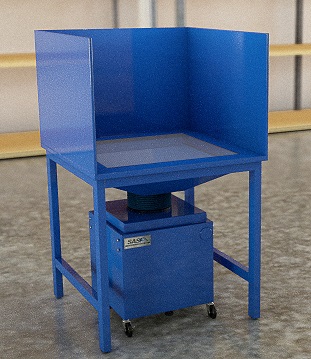
According to the U.S. Bureau of Labor Statistics, in 2012 there were approximately 5,750 people employed in the Shoe and Leather Workers and Repairers industry.
During a typical day, these workers are exposed to a host of chemical vapors and particulate generated during the repair and refinishing process.
Whether it is the rubber cement and adhesive used to attach new soles, the thinners and solvents used to dilute colors and dyes, or the actual dyes and paints used to stain and finish the leather, each of these processes emit hazardous fume that may pose harmful side effects if inhaled over long periods of time.
Avoid Breathing these Common Ingredients
 Four major chemicals can be found in a variety of common shoe repair and refinishing products: Ethanol, Heptane, Toluene and Ethyl Acetate.
Four major chemicals can be found in a variety of common shoe repair and refinishing products: Ethanol, Heptane, Toluene and Ethyl Acetate.
All of these chemicals have regulated workplace exposure limits and should be handled with respiratory care in mind.
The following tables denote the exposure limits set by various regulatory agencies and the health effects one may encounter when working with these chemicals:
|
ETHANOL |
||
| Exposure Limit | Limit Values | Health Factors and Target Organs |
| OSHA Permissible Exposure Limit (PEL) | 1,000 ppm TWA | Headache, fatigue, stupor, irritation of the upper respiratory tract and eyes |
| National Institute for Occupational Safety and Health (NIOSH) Recommended Exposure Limit (REL) | 1,000 ppm TWA | Teratogenic and reproductive effects, eye, respiratory, and skin irritation |
| American Conference of Governmental Industrial Hygienists (ACGIH) Threshold Limit Value (TLV) | 1,000 ppm STEL | Irritation of the upper respiratory tract and eyes |
|
HEPTANE |
||
| Exposure Limit | Limit Values | Health Factors and Target Organs |
| OSHA PEL | 500 ppm TWA | Dizziness, vertigo, incoordination, hilarity, persistent gasoline taste in mouth, persistent gasoline taste in mouth, persistent gasoline taste in mouth |
| NIOSH REL | 85 ppm TWA | Lightheadedness, hilarity, dizziness, vertigo, incoordination, semi-consciousness, unconsciousness, irritation of the eyes, nose, throat, and skin; persistent gasoline taste in mouth |
| ACGIH TLV | 400 ppm TWA | Dizziness, vertigo, incoordination, hilarity, respiratory irritation, persistent gasoline taste in mouth |
|
TOLUENE |
||
| Exposure Limit | Limit Values | Health Factors and Target Organs |
| OSHA PEL | 200 ppm TWA | Central nervous system depression, causing fatigue, headache, confusion, paresthesia, dizziness, and muscular incoordination, irritation of the eyes, mucous membranes, and upper respiratory tract |
| NIOSH REL | 100 ppm TWA | Fatigue, weakness, confusion, headache, dizziness, drowsiness, unconsciousness, irritation of the eyes, respiratory tract, and skin |
| ACGIH TLV | 20 ppm TWA | Female reproductive system damage and pregnancy loss, central nervous system impairment and visual impairment |
Note: Sentry Air Systems tested our 10 lb. activated carbon filter against Toluene vapor, you can view the results and entire report on our website.
|
ETHYL ACETATE |
||
| Exposure Limit | Limit Values | Health Factors and Target Organs |
| OSHA PEL | 400 ppm TWA | Mild narcosis at high concentrations, mild eye, nose, and upper respiratory irritation, strong odor |
| NIOSH REL | 400 ppm TWA | Narcosis at high concentrations, eye and respiratory irritation |
| ACGIH TLV | 400 ppm TWA | Eye, nose, and upper respiratory irritation, strong odor |
A common route of exposure to these chemicals in shoe repair facilities, is through the inhalation of vapor and mist. Because of this, a majority of these chemical’s Material Safety Data Sheets recommend proper ventilation controls to maintain appropriate air quality levels.
In order to create a healthier work environment and reduce exposure to these chemicals, it is important to implement a source-capture air filtration system that arrests vapor and particulate at the source of emission before they enter the operator’s breathing zone.
Modular Workstation with Air Filtration
The molecular weights of these chemicals are slightly greater than air, meaning their higher vapor densities will cause the vapors to “drop”. The downward flow design of the negative-pressure, downdraft table is ideally suited for capturing these vapors.
 Our Mini Downdraft Workstation is comprised of a Model 400 Portable Floor Sentry attached to a modular work surface by a plenum. The work surface has an open grill pattern on the base so that vapor-laden air can be pulled down towards the filter chamber; avoiding the operator’s breathing zone.
Our Mini Downdraft Workstation is comprised of a Model 400 Portable Floor Sentry attached to a modular work surface by a plenum. The work surface has an open grill pattern on the base so that vapor-laden air can be pulled down towards the filter chamber; avoiding the operator’s breathing zone.
The surface surround creates a semi-enclosed work area for greater containment while still allowing the operator ample space to work. This negative-pressure system is compact, highly portable and its ductless technology means no costly exhaust ducts or make-up air is required.
The Model 400 utilizes a powerful fan to pull up to 700 CFM of fume and vapor-filled air into the filter chamber. The air is then scrubbed of hazardous particulate before being recirculated back into the work area. Available filter media includes HEPA particulate filtration [up to 99.97% efficient on particles 0.3 microns and larger], Activated Carbon and Specialty Carbon Blends for VOC and odor filtration [efficiency varies depending upon application], ASHRAE and ULPA particulate filters are also available.
Reap the benefits of a healthier workplace without exhausting your budget. For chemical and VOC odor control, consider implementing a mini downdraft workstation at your shoe repair facility.
Contact Sentry Air
For more information about chemical vapor filtration, or to receive a free quote on any of our products, give Sentry Air a call at 800.799.4609, email sales@sentryair.com, visit our website or fill out the feedback form below.
Resources
Occupational Employment Rates: http://www.bls.gov/oes/current/oes516041.htm
Ethanol Exposure Limits: https://www.osha.gov/dts/chemicalsampling/data/CH_239700.html
Heptane Exposure Limits: https://www.osha.gov/dts/chemicalsampling/data/CH_244599.html
Toluene Exposure Limits: https://www.osha.gov/dts/chemicalsampling/data/CH_272200.html
Ethyl Acetate Exposure Limits: https://www.osha.gov/dts/chemicalsampling/data/CH_239500.html

 Made in the USA
Made in the USA